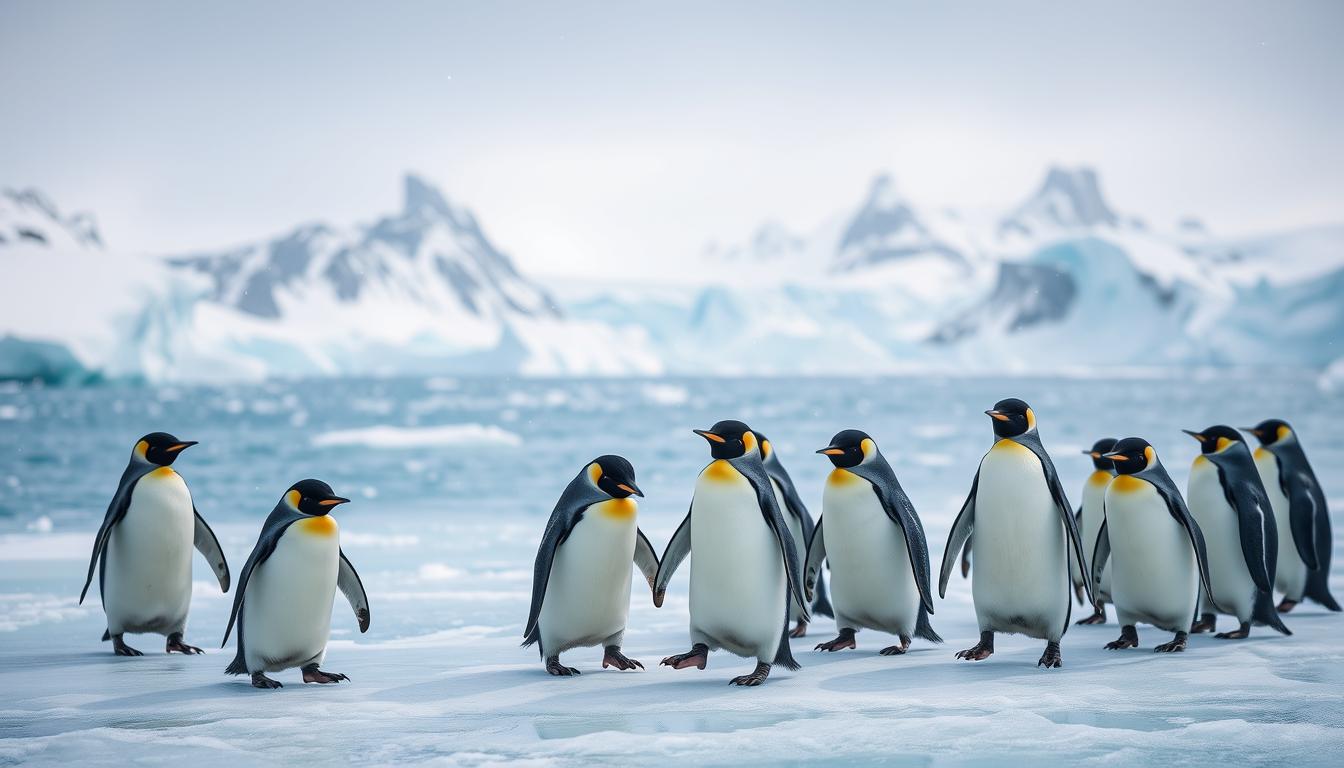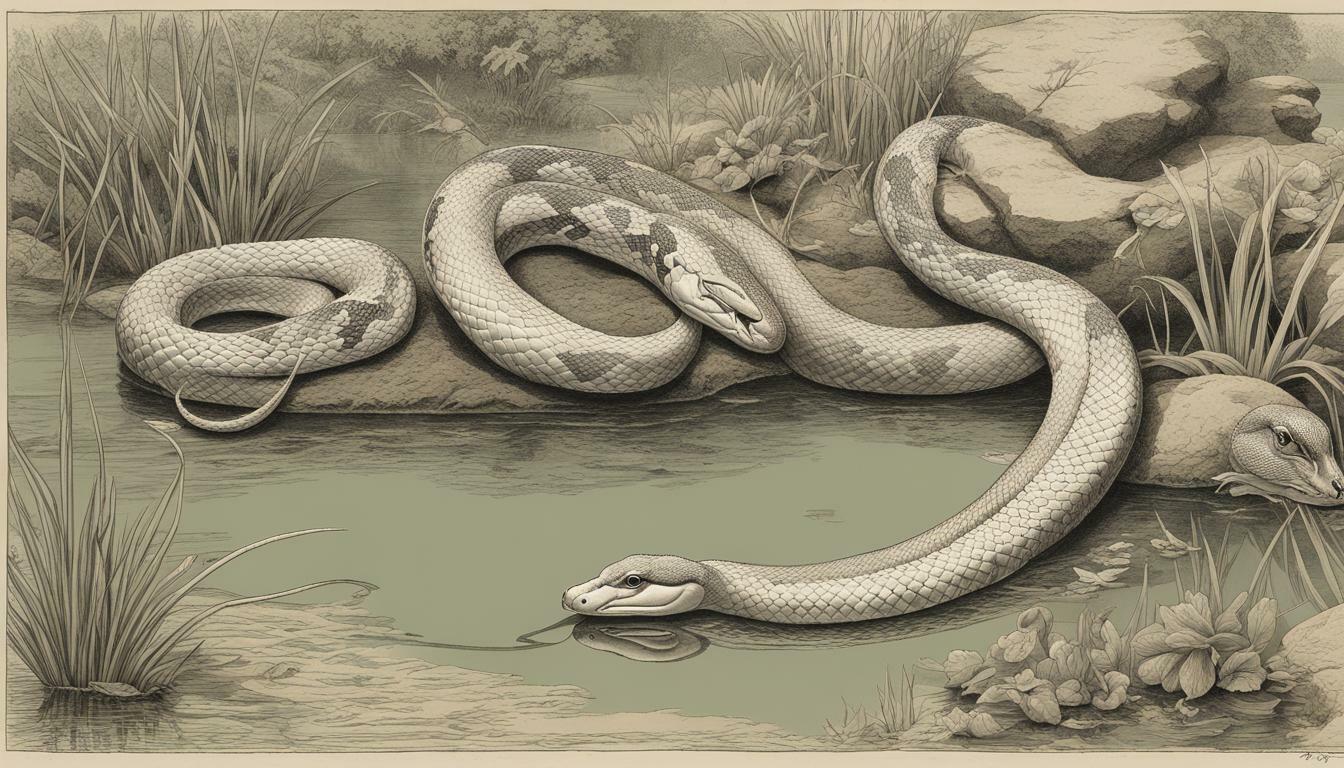5 Fascinating Facts About Penguins You Need to Know

Table of content:
Penguins are special birds found only in the Southern Hemisphere. They have black and white feathers and are great at swimming. Each penguin species is unique and has its own special traits. Let’s dive into five cool facts about penguins.
First, scientists now know of 18 penguin species. This number grew when they split the rockhopper penguin into two. Penguins have been around for about 22 million years, starting in Australia, New Zealand, and the South Pacific.
Penguins vary in size. The Little Penguin is small, at 12-14 inches tall. The Emperor Penguin is huge, up to 45 inches tall. Even bigger penguins, almost as tall as humans, lived 30 million years ago in New Zealand.
There are many penguin species, but some are in danger. The African and Galápagos penguins are endangered. Sadly, half of all penguin species are threatened or endangered. We need to help protect these amazing birds.
Penguins are amazing swimmers and divers. The Gentoo Penguin swims up to 30 miles per hour. The Emperor Penguin can hold its breath for 22 minutes underwater. These skills show how penguins have evolved to be great swimmers.
Physical Characteristics
Penguins are amazing creatures that live in the water. They have solid bones, not hollow ones, to help them swim better. Their bodies are shaped for speed, with a big head, short neck, and long body.
They also have a special gland near their tail. This gland makes waterproof oil for their feathers. They spend hours each day to keep their feathers dry and warm.
Penguins don’t have teeth but have sharp ridges in their mouths. These ridges help them eat their food. Their feet are great for walking and swimming, making them very good in the water.
The Emperor penguin is very tall and heavy. The Little penguin is small and light. Penguins come in all shapes and sizes, all adapted for life in the water.
Coloration and Camouflage
Penguins are known for their black and white feathers. This helps them hide underwater. It’s a clever trick to keep them safe from predators.
The dark feathers on their backs make them hard to see from above. Their white bellies blend with the water’s surface. This makes them almost invisible to predators below.
Some penguins have even more tricks to hide. The Chinstrap Penguin has a black band under its chin. This helps it blend with rocky shores. The Yellow-Eyed Penguin’s bright eyes also help it hide.
Penguins’ clever hiding tricks show how smart they are. They blend in to avoid danger. This lets them hunt, breed, and protect their young.
Habitat and Distribution
Penguins live in the Southern Hemisphere. They are found in many places. This includes Antarctica, the Antarctic islands, and the Galapagos Islands.
They also live in South Africa, New Zealand, Australia, Peru, and Chile. The Galapagos Penguin is special. It’s the only one found north of the equator.
Penguins and polar bears don’t live together. Polar bears are in the Arctic, north of the equator. Penguins live in the cold parts of the Southern Hemisphere.
There are 18 different kinds of penguins. Each one looks and acts differently. The Galapagos Penguins are special. They are the only penguins found north of the equator.
Penguins live in many places. This includes icy Antarctica and warm South America and Australasia. They show how well they can adapt and survive.
Diet and Foraging
Penguins are amazing birds that need to eat a lot because they burn energy fast. They dive into the ocean to find food. This is how they catch their prey.
Each penguin type dives differently. Emperor Penguins dive as deep as 530 meters. Gentoo Penguins dive about 200 meters. King Penguins dive down to around 350 meters. They use their feet to steer while swimming and hunting.
- Adélie penguins eat a lot of krill, fish, and squid every year.
- Penguins hunt in areas from 9 to 559 miles from their homes. Emperor penguins can go up to 903 miles in one trip.
- Emperor penguins have been found with 10 lbs of stones in their stomachs. Other penguins like king, rockhopper, and macaroni penguins swallow stones on purpose.
Penguins have many ways to hunt for food. They are very good at living in the ocean.
Social Behavior
Penguins are really interesting because of how they act together. They form groups called “rafts” in the water and “waddles” on land. This shows they like to be together.
When it’s time to breed, penguins often choose one mate for the season. Some males even give rocks to females to win them over. The females use these rocks to build nests.
Penguins also huddle together to stay safe and warm. This helps them fight off predators and keep warm in cold places. It shows how important penguin social structure is to them.
The way penguins mate and parent is also very interesting. Males take turns incubating eggs, and both parents help feed and care for their chicks. This shows their strong family bonds.
In the end, penguins’ social ways help them survive in tough places. Learning about their social lives, mating, and parenting helps us appreciate them more. It shows how important they are to their ecosystems.
Adaptations for Swimming
Penguins are amazing birds that can “fly” underwater. Their wings are made for swimming, not flying. They have solid bones that help them dive deep.
The Gentoo Penguin is super fast in the water. They can swim up to 36 km/h. This is four times faster than Olympic swimmers. Their body shape and wings make them great swimmers.
- Penguins can move faster on snow and ice by “tobogganing” than a human can run.
- Penguins have adapted short, stiff flippers for efficient swimming underwater.
- Penguins trap air in their feathers for insulation against the cold and to reduce drag while swimming by releasing tiny bubbles.
The adaptive evolution processes have made penguins amazing swimmers. They have bodies and wings made for swimming. Penguins can swim fast and move through the water easily.
Diving Ability
Penguins are known for their amazing diving skills. They use these skills to hunt and explore the sea. The emperor penguins can dive as deep as 564 meters.
The blue whale, the biggest animal on Earth, can dive even deeper, up to 1,000 meters. This is almost double what penguins can do.
Penguins usually dive between 30 and 564 meters. But, emperor penguins can stay underwater for up to 22 minutes. This shows how well they are made for diving.
Other penguins, like Adélie penguins, can dive as deep as 180 meters. This shows that different penguins have different diving skills. These skills help them find food and survive in the sea.
Penguins have special features that help them dive well. Their flippers help them swim fast, up to 20 km per hour. Their long bills and spiny tongues help them catch fish.
Penguins can also keep cool by flushing blood through their flippers and feet. This makes their feet turn pink when it’s warm. They also have special glands to filter out salt from the sea.
Penguins’ diving skills show how well they have adapted to the sea. Learning about penguins helps us understand the amazing world around us.
Conclusion
Penguins are amazing birds with cool adaptations. But, they face big challenges. The IUCN says ten penguin species are in trouble.
The African Penguin and Galapagos Penguin are in big trouble. Climate change and overfishing hurt their homes and food. This makes it hard for them to survive.
We need to help penguins and their homes. By learning about their problems and helping, we can make a difference. Your help can keep penguins amazing for future generations.
Welcome. I’m Adreena Shanum, the proud owner of this website, and I am incredibly passionate about animals, especially poultry. I founded adreenapets.com as a labor of love, stemming from my desire to share my knowledge and experiences with poultry enthusiasts worldwide.




